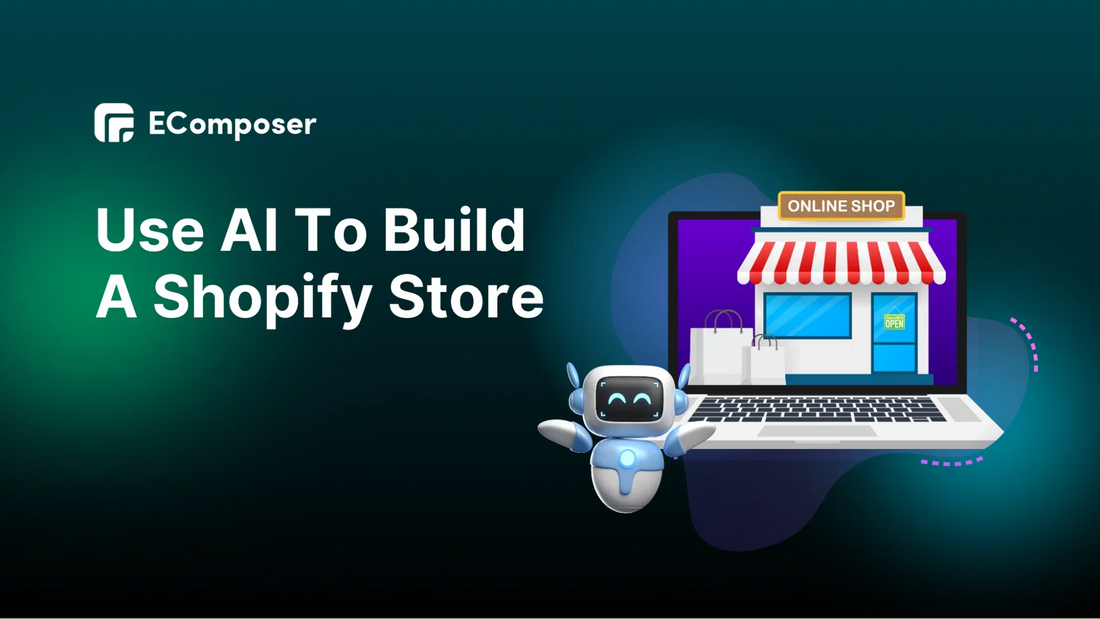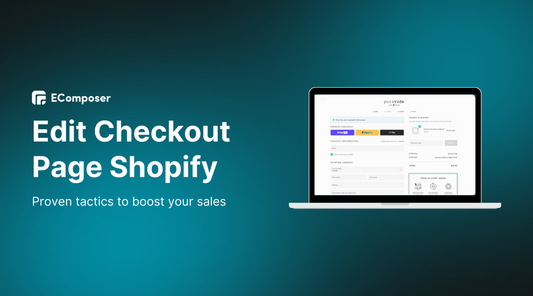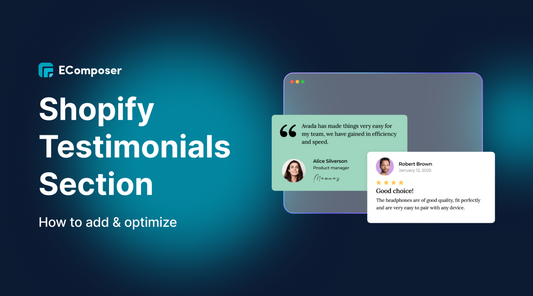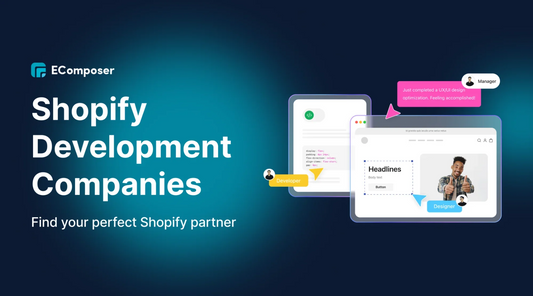How to use AI to Build A Shopify Store

Table Of Contents
In today's fast-paced eCommerce landscape, harnessing the power of artificial intelligence (AI) can give your Shopify store a significant edge. From designing eye-catching pages to personalizing customer experiences, AI tools are revolutionizing how online merchants operate. This guide will walk you through the way to use AI to build a Shopify store, enhance product listings, and automate marketing efforts. Get ready to transform your Shopify experience and watch your sales soar with the help of cutting-edge AI technology!
AI Trends in eCommerce

Personalization
AI algorithms analyze customer data to create personalized shopping experiences. Enhanced recommendations, tailored marketing campaigns, and customized landing pages lead to higher customer engagement and conversion rates. Customers expect personalized experiences, and brands that fail to meet these expectations need help to retain them.
Chatbots and Virtual Assistants
More eCommerce businesses are implementing AI-driven chatbots for customer service and support. These bots provide 24/7 assistance, handle multiple inquiries simultaneously, and can resolve issues quickly. This increases customer satisfaction and reduces the workload on human agents, allowing them to focus on more complex issues.
Visual Search and Recognition
AI-powered visual search tools allow customers to search for products using images instead of text. This trend enhances user experience by enabling shoppers to find products more intuitively. Retailers can benefit from increased sales as customers can easily discover items they might not have been able to describe accurately.
Predictive Analytics
Retailers use AI to analyze consumer behavior and forecast future buying trends. Predictive analytics can inform inventory management, helping businesses optimize stock levels and reduce costs. By anticipating demand, companies can better align their marketing strategies, minimizing waste and maximizing profitability.
Dynamic Pricing
AI tools adjust pricing in real time based on demand, competition, and consumer behavior. This trend allows retailers to optimize sales and margins by ensuring their prices are competitive. However, careful management is required to avoid alienating customers with frequent price changes.
Automated Warehousing and Fulfillment
AI is increasingly used in inventory management and logistics to streamline operations. Automation of warehousing processes reduces human error and increases efficiency, leading to faster order fulfillment. This is crucial for meeting the rising customer expectations for speedy delivery.
Fraud Detection and Prevention
AI systems analyze transaction patterns to identify and prevent fraudulent activities. Enhanced security measures protect both retailers and customers, fostering trust in online shopping. This trend is vital as eCommerce fraud continues to rise.
Voice Commerce
The integration of AI in voice-activated devices is facilitating voice shopping. As more consumers use smart speakers to make purchases, retailers must optimize their platforms for voice search. This trend indicates a shift towards convenience, requiring brands to adapt their marketing strategies.
Augmented Reality (AR) and Virtual Reality (VR)
AI is driving the development of AR and VR tools that enhance the shopping experience. These technologies allow customers to visualize products in their environments, leading to increased confidence in purchasing decisions. This trend is particularly impactful in industries like furniture and fashion.
Data-Driven Decision Making
AI tools provide valuable insights through data analysis, influencing strategic business decisions. Retailers can make informed decisions about product offerings, marketing campaigns, and customer engagement strategies, ultimately driving growth and competitiveness.
The integration of AI in eCommerce is not just a passing trend; it's becoming essential for retailers looking to thrive in a competitive landscape.
Why should you use AI to build a Shopify store?
-
Enhance Personalization for Customers
AI analyzes customer data to deliver tailored product recommendations and marketing messages, leading to increased engagement and higher conversion rates. -
Provide 24/7 Customer Support
AI chatbots offer instant assistance for customer inquiries, ensuring support is available around the clock and freeing up your team for complex issues. -
Gain Data-Driven Insights
AI tools provide valuable analytics on customer behavior and trends, helping you make informed decisions on inventory, marketing strategies, and product offerings. -
Increase Operational Efficiency
Automate repetitive tasks like inventory management and order fulfillment, allowing you to focus on strategic growth while reducing human error. -
Optimize Pricing Dynamically
AI algorithms adjust pricing in real-time based on market trends and customer behavior, maximizing profit margins and ensuring competitiveness. -
Implement Targeted Marketing Campaigns
AI enhances advertising efforts by analyzing customer data for targeted outreach, leading to improved engagement and conversion rates. -
Utilize Visual Search Capabilities
Implement AI-powered visual search tools that enable customers to find products by uploading images, thus enhancing their shopping experience. -
Enhance Fraud Prevention Measures
AI systems monitor transactions for suspicious activities, providing enhanced security and building customer trust through secure shopping experiences. -
Support Scalability as You Grow
AI tools adapt to increasing traffic and orders, helping you manage growth without compromising quality or customer service. -
Achieve a Competitive Edge in the Market
Embracing AI technologies positions your store as an innovative leader in the eCommerce space, attracting more customers and boosting sales.
Using AI in your Shopify store not only streamlines operations but also enhances customer experiences and drives sales. By leveraging AI technology, you can create a more efficient, personalized, and profitable online business.
Comprehensive guide to building a Shopify store with AI
1. Research product

Effective product research is the foundation of a successful Shopify store. With AI tools, you can streamline this process and uncover valuable insights about market trends and consumer preferences. Here’s how to leverage AI for product research:
1.1. Use AI-Powered Market Research Tools
- Product Discovery Platforms: Utilize AI-driven platforms like Jungle Scout, Helium 10, or Oberlo. These tools analyze vast amounts of data to help you identify trending products, estimate sales volume, and evaluate competition.
- Market Analysis Reports: Access AI-generated reports that provide insights into consumer behavior, market trends, and emerging categories.
1.2. Analyze Search Trends
- Google Trends: Monitor search interest over time for specific products or categories. AI-enhanced analytics can identify seasonal trends, helping you time your product launches effectively.
- Keyword Research Tools: Use tools like Ahrefs or SEMrush to discover popular keywords related to your products. These insights can guide your product selection based on search volume and competition.
1.3. Leverage Social Media Insights
- Social Listening Tools: AI tools like Hootsuite or Brandwatch can analyze social media conversations around specific products or industries. This helps you gauge consumer sentiment and spot potential opportunities or threats.
- Influencer Insights: Identify trending products through influencers in your niche. AI can help analyze engagement metrics to determine which products resonate most with their audiences.
1.4. Conduct Competitor Analysis
- AI-Driven Competitor Research Tools: Tools like SimilarWeb and BuzzSumo use AI to analyze competitors’ product offerings, pricing strategies, and customer engagement tactics. Understanding what works for your competitors can inform your product decisions.
- Review Analysis: Use AI to scrape and analyze reviews from competitors' products. This can reveal common customer pain points, preferences, and features that drive purchasing decisions.
1.5. Explore Customer Preferences
- Surveys and Feedback: Utilize AI tools like SurveyMonkey or Typeform to create surveys that gather customer preferences and pain points. Analyzing responses with AI can help you pinpoint popular product features.
- AI-Powered Recommendation Systems: If you already have a customer base, use AI algorithms to analyze past purchasing behavior and preferences. This can suggest products that align with your customers' interests.
1.6. Validate Product Ideas
1.7. Stay Updated with Market Trends
AI News Aggregators: Use platforms like Feedly or NewsAPI to stay informed about the latest industry trends and news. AI can curate relevant articles, helping you adapt your product offerings to meet changing market demands.
Researching products effectively sets the stage for your Shopify store's success. By leveraging AI tools and technologies, you can gain valuable insights into market trends, consumer preferences, and competitive landscapes.
2. Setting Up Your Shopify Store with AI Tools

Once you’ve completed your product research, the next crucial step is to set up your Shopify store effectively. AI tools can streamline this process, making it easier to create a professional, user-friendly online shop.
2.1. Choose the Right Shopify Plan
Use AI-driven comparison tools to analyze the available Shopify plans. These tools can help you select a plan that aligns with your business goals, budget, and expected sales volume.
2.2. Store Design and Theme Selection
Leverage EComposer - Best Shopify Page Builder, the best Shopify page builder app, to create a stunning and customizable store design. EComposer’s drag-and-drop interface simplifies layout creation, allowing you to build visually appealing pages without coding knowledge.
Key features
- Drag-and-Drop Functionality: Easily add, rearrange, and customize elements on your page without any coding knowledge.
- Pre-built Templates: Choose from a variety of professionally designed templates tailored for different industries, enabling quick setup and customization.
- Element Library: Access a rich library of elements, including product grids, image sliders, testimonials, and more, to enhance the visual appeal of your store.
- Real-time Editing: Make changes and see them in real time, allowing for quick adjustments and fine-tuning to your store’s design.
- Third-Party App Integrations: Seamlessly integrate with other essential Shopify apps, adding extra functionality to your store.
2.3. Optimize Your Store’s Structure
- AI Site Mapping Tools: Use AI-powered tools like Slickplan to create a logical site structure. These tools can help you organize product categories, collections, and navigation menus, making it easier for customers to find what they need.
- Dynamic Category Creation: Leverage AI to automatically generate product categories based on customer preferences and search trends, ensuring your store aligns with what shoppers are looking for.
2.4. Set Up Payment Gateways
- Smart Payment Solutions: AI tools can analyze various payment gateways (like Stripe, PayPal, and Shopify Payments) to recommend the best options based on your customer demographics and location, optimizing transaction success rates.
- Fraud Detection: Implement AI-based fraud detection tools to secure transactions. These tools analyze patterns in transactions to identify potentially fraudulent activities before they occur.
2.5. Analytics and Tracking Setup
- AI Analytics Tools: Integrate AI analytics solutions like Google Analytics with AI enhancements (such as Piwik PRO) to gain deeper insights into customer behavior and store performance. These tools can provide actionable recommendations for improving your store.
- Performance Monitoring: Set up automated reporting to monitor key performance indicators (KPIs) such as traffic, conversion rates, and customer acquisition costs. AI tools can highlight trends and suggest areas for improvement.
Setting up your Shopify store with AI tools simplifies the process, ensuring that you create an attractive, functional, and efficient online shop.
3. Optimizing Product Listings and Descriptions with AI

With your Shopify store set up, the next step is to optimize your product listings and descriptions. Effective product listings can significantly impact your sales and conversions. AI tools can enhance your product pages by making them more engaging and optimized for search engines. Here’s how to do it:
3.1. AI-Powered Content Generation
- Automated Descriptions: Utilize AI content generation tools like Copy.ai, Jasper, or ChatGPT to create compelling and unique product descriptions. These tools analyze existing high-performing listings and generate engaging copy that highlights key features, benefits, and unique selling points of your products.
- Keyword Optimization: AI can assist in identifying relevant keywords and phrases to include in your product descriptions. By using tools like Ahrefs or SEMrush, you can optimize your listings for search engines, improving your chances of being discovered by potential customers.
3.2. Dynamic Product Attributes
- Personalized Attributes: Implement AI algorithms that analyze customer behavior and preferences to suggest personalized product attributes (like color, size, or style). This helps tailor your listings to meet the specific needs of different customer segments, enhancing user experience.
- Variant Optimization: Use AI to create and manage product variants based on historical data automatically. This ensures you offer the most popular options and combinations without overwhelming customers with too many choices.
3.3. High-Quality Images and Visuals
- Automated Image Editing: Leverage AI image editing tools such as Canva or Remove.bg to enhance product images. These tools can automatically adjust brightness, remove backgrounds, and apply filters, ensuring that your visuals are appealing and professional.
- 360-Degree Views and AR: Consider using AI to implement 360-degree product views or augmented reality (AR) features. This allows customers to visualize products better, improving their confidence in making a purchase.
3.4. Customer Review Analysis
- Sentiment Analysis: AI tools can analyze customer reviews to identify common sentiments, feedback, and concerns. This analysis can help you refine your product descriptions and address potential objections directly in your listings.
- Highlighting Positive Feedback: Use AI to automatically pull positive customer reviews and display them prominently on your product pages, enhancing credibility and trustworthiness.
3.5. A/B Testing for Listings
- AI-Driven A/B Testing: Implement AI-powered tools to conduct A/B testing on your product listings. These tools can analyze performance metrics like click-through rates and conversion rates for different descriptions, images, and layouts, allowing you to identify the most effective combinations.
- Real-Time Adjustments: Use AI to make real-time adjustments to your listings based on performance data. This adaptive approach ensures your product pages are always optimized for the best results.
3.6. SEO Best Practices
Conduct AI-Powered Keyword Research
- Use AI Tools: Leverage AI-powered keyword research tools like Ahrefs, SEMrush, or Moz to find high-traffic, relevant keywords for your products. These tools can analyze search trends and competition, providing insights into which keywords are worth targeting.
- Identify Long-Tail Keywords: Focus on long-tail keywords that are more specific and often less competitive. For example, instead of just “shoes,” target phrases like “best running shoes for women” to attract a more qualified audience.
Generate Compelling Product Titles
- AI Content Generators: Use AI content generation tools like Copy.ai or Jasper to craft engaging product titles that include primary keywords. A compelling title not only attracts clicks but also improves search rankings.
- Format for SEO: Start with your main keyword and follow it with descriptive phrases. For example, “Lightweight Women’s Running Shoes – Breathable, Comfortable & Durable.”
Craft Unique Product Descriptions
- AI Writing Assistants: Use AI writing assistants to generate unique and engaging product descriptions. Ensure that each description focuses on the product’s features and benefits while integrating relevant keywords naturally.
- Avoid Duplicate Content: AI can help you create variations of product descriptions to avoid duplication, which can negatively impact SEO. Aim for at least 300 words for each product to provide ample information for both users and search engines.
Implement SEO-Friendly Images
- Optimize Images with AI: Use AI tools like Canva or Adobe Photoshop to enhance and compress images for faster loading times. High-quality images improve user experience and can boost SEO.
- Use Descriptive Alt Text: Write descriptive alt text for each image, incorporating relevant keywords. For example, “women-running-shoes-lightweight-breathable.jpg” helps search engines index your images correctly.
Leverage AI for Schema Markup
- Implement Structured Data: Use AI tools to add schema markup to your product pages, providing search engines with additional information about your products, such as prices, availability, and reviews.
- Use Google’s Structured Data Markup Helper: This tool can assist you in creating the necessary code to enhance your listings in search results with rich snippets, making them more appealing to potential customers.
Optimize Meta Tags with AI Insights
- Generate Meta Titles and Descriptions: Use AI tools to generate SEO-friendly meta titles and descriptions that incorporate your main keywords. Keep meta titles under 60 characters and descriptions under 160 characters for optimal display in search results.
- A/B Testing for Meta Tags: Utilize AI-driven A/B testing tools to experiment with different meta tags and analyze performance metrics. This helps you determine which combinations yield the best click-through rates.
Monitor Performance with AI Analytics
- AI Analytics Tools: Use AI analytics tools like Google Analytics or Hotjar to track the performance of your product pages. Monitor key metrics such as organic traffic, bounce rates, and conversion rates.
- Actionable Insights: Based on the data, adjust your SEO strategy accordingly. AI can help identify patterns in user behavior, enabling you to optimize product listings further.
Using AI for Shopify SEO optimization in your Shopify store can significantly enhance your product visibility and drive more traffic.
4. Enhancing Customer Experience with AI-Powered Personalization

In today's competitive eCommerce landscape, providing a personalized shopping experience can set your Shopify store apart from the rest. AI-powered personalization tailors your offerings to meet individual customer preferences, leading to higher engagement and conversion rates. Here’s how to leverage AI to enhance the customer experience:
4.1. Personalized Product Recommendations
- AI Algorithms for Suggestions: Utilize AI-driven recommendation engines like Nosto or Dynamic Yield to analyze customer behavior, purchase history, and browsing patterns. These tools can suggest products tailored to individual customers, making shopping more accessible and more relevant.
- Cross-Selling and Upselling: Implement personalized cross-selling and upselling strategies. For instance, if a customer views a pair of shoes, the AI can recommend matching accessories, enhancing their shopping experience while increasing their average order value.
4.2. Customized Marketing Campaigns
- Segmentation Using AI: Leverage AI tools like Klaviyo or Omnisend to segment your audience based on their behavior, preferences, and demographics. This allows you to create targeted email campaigns and promotions tailored to specific groups, ensuring your messaging resonates.
- Dynamic Content: Use AI to create dynamic content for your emails and website that adapts based on user behavior. For example, if a customer frequently browses sports equipment, your email marketing can highlight new arrivals in that category.
4.3. Enhanced Customer Support
- AI Chatbots for Instant Assistance: Implement AI-powered chatbots like Tidio or Zendesk to provide 24/7 customer support. These chatbots can handle common inquiries, guide customers through the purchasing process, and even recommend products based on customer needs.
- Personalized FAQ Responses: Use AI to analyze customer inquiries and create personalized responses for common questions. This not only speeds up response times but also enhances customer satisfaction by addressing specific concerns.
4.4. Tailored Shopping Experience
- Behavioral Tracking: Use AI tools to track user behavior on your site. This data can help you understand what customers are interested in and allow you to tailor their shopping experience. For example, if a customer often browses for eco-friendly products, your homepage can highlight those items.
- Adaptive Layouts: Implement AI algorithms that adjust your store’s layout based on user preferences. For instance, frequent visitors might see a customized homepage layout featuring their favorite categories or products, creating a familiar and engaging shopping environment.
4.5. Customer Feedback Analysis
- Sentiment Analysis Tools: Use AI to analyze customer feedback and reviews. Tools like MonkeyLearn can help you identify trends and sentiments in customer opinions, allowing you to make informed decisions about product offerings and customer service improvements.
- Personalized Follow-Ups: After purchase, use AI to send personalized follow-up emails asking for feedback. This not only shows customers that you value their opinions but also provides you with insights to improve your store.
4.6. AI-Driven Loyalty Programs
- Personalized Rewards: Leverage AI to create personalized loyalty programs that reward customers based on their shopping habits. For example, frequent shoppers can receive tailored offers or discounts that align with their purchase history.
- Predictive Analytics for Retention: Use predictive analytics to identify at-risk customers and proactively engage them with personalized incentives. By understanding when customers are likely to churn, you can offer tailored promotions to encourage them to return.
Incorporating AI-powered personalization into your Shopify store can significantly enhance the customer experience, leading to increased satisfaction and loyalty.
5. AI-Driven Marketing and Sales Automation

After setting up and personalizing your Shopify store, it’s essential to reach and retain customers effectively. AI-driven marketing automation can save time, streamline your efforts, and increase conversions by targeting the right customers with the right message at the right time. Here’s how to make the most of AI for marketing and sales automation:
5.1. Automated Email Campaigns
- Behavior-Triggered Emails: Use AI tools like Klaviyo or Mailchimp to create behavior-triggered email sequences. For example, automatically send a personalized welcome email after a customer signs up or an abandoned cart reminder if they leave items in their cart. AI ensures that these emails are timely and relevant, increasing the chances of engagement.
- Dynamic Content Personalization: AI can adjust email content based on each customer’s browsing or purchase history. For instance, customers who recently viewed products in a specific category might receive an email highlighting related items or special offers in that category.
5.2. Social Media Advertising Optimization
- Audience Segmentation and Targeting: AI-powered platforms like Facebook Ads Manager and Google Ads use machine learning to analyze user behavior and segment audiences based on interest, location, and purchase intent. This helps you run highly targeted ads, reaching potential customers more effectively.
- Ad Creative Optimization: Some AI tools can analyze your ad performance in real time and automatically optimize images, copy, and targeting. Tools like AdRoll use AI to test various versions of your ads, helping you maximize your ad spend and improve ROI without manual adjustments.
5.3. Predictive Sales Analytics
- Forecasting Demand and Trends: AI tools can analyze historical sales data, industry trends, and seasonality to predict future demand for your products. Tools like ClearStory or Skyl.ai use predictive analytics to help you stay ahead of demand shifts and adjust your inventory accordingly.
- Identifying High-Value Customers: Use AI to predict customer lifetime value and identify high-value customers. By understanding which customers are likely to make repeat purchases, you can focus marketing efforts and offer exclusive promotions to keep them engaged.
5.4. Chatbots for Sales and Lead Generation
- Automated Sales Assistance: AI chatbots like Tidio and Zendesk can answer customer inquiries and guide them through the sales process. They can also recommend products, helping customers find what they need while boosting conversion rates.
- Lead Qualification: AI chatbots can qualify leads by gathering basic information and identifying purchase intent. For example, when a visitor expresses interest in a product, the chatbot can suggest similar items or ask if they’d like to be contacted by a sales representative, seamlessly integrating lead generation into customer support.
5.5. Personalized Retargeting Campaigns
- Product-Specific Retargeting: AI can analyze each customer’s browsing and purchase history to run highly personalized retargeting ads. For example, if a customer sees a specific item and doesn’t make a purchase, AI can generate ads that feature that item or offer a related discount.
- Dynamic Retargeting for Cart Abandonment: AI-powered retargeting platforms can display dynamic ads to remind customers of abandoned carts. For example, showing a carousel of the products they left behind can increase the chances of a completed sale.
5.6. Optimized Product Launch and Promotion Strategy
- Market Testing with AI: AI tools can help you test your products in select audiences or locations before a full launch, helping you refine your marketing strategy based on real-time customer feedback.
- Seasonal and Event-Based Campaigns: AI tools analyze past sales trends around key dates (like holidays or BFCM) to help you time your campaigns strategically. For instance, AI can recommend when to start promotions or when to increase ad spend, maximizing sales during peak times.
AI-driven marketing and sales automation is a game-changer for Shopify store owners looking to scale efficiently. By automating email marketing, optimizing social media ads, forecasting sales, and personalizing retargeting efforts, you can build meaningful connections with customers while saving time and boosting revenue.
6. Inventory Management and Order Fulfillment with AI

Effective inventory management and seamless order fulfillment are crucial for running a successful Shopify store. AI-driven tools help you maintain optimal stock levels, reduce fulfillment time, and improve the customer experience by minimizing order delays. Here’s how to streamline these processes with AI:
6.1. Demand Forecasting and Inventory Optimization
- Predicting Stock Levels: AI-powered forecasting tools like ClearStory or Netstock analyze sales history, seasonal trends, and real-time demand to predict your future stock needs accurately. This helps you avoid stockouts and overstocking, reducing the risk of unsold inventory and ensuring popular items remain available.
- Dynamic Stock Reordering: AI systems can automate reorder alerts and even initiate purchase orders with suppliers based on preset thresholds. For example, if a particular item’s stock drops below a certain level, the AI will automatically notify your supplier or place an order, keeping inventory optimized.
6.2. Warehouse Management and Order Processing
- AI-Powered Sorting and Packing: In more extensive operations, AI can optimize how products are stored and retrieved within the warehouse, helping you pack and ship orders faster. AI systems like 6 River Systems use robotics and machine learning to help streamline picking, sorting, and packing processes, ultimately improving order accuracy and fulfillment speed.
- Order Prioritization: AI can prioritize orders based on customer segmentation, product availability, or shipping destination. For example, VIP customers or high-value orders might be given priority to ensure faster shipping, leading to higher satisfaction and repeat purchases.
6.3. Real-Time Inventory Tracking
- Multi-Channel Inventory Syncing: AI-driven inventory management systems like Skubana or TradeGecko keep stock levels updated in real-time across multiple sales channels. This is essential for Shopify stores selling on various platforms like Amazon, eBay, or social media to prevent overselling and ensure accurate inventory counts.
- Automated Stock Alerts: AI can generate real-time alerts when stock is running low or demand surges unexpectedly. This helps you respond quickly to demand fluctuations by adjusting stock levels, running promotions, or shifting ad spending to maximize sales of in-stock products.
6.4. Shipping and Delivery Optimization
- AI-Driven Route Optimization: AI-powered logistics tools like ShipHawk or OptimoRoute analyze factors like delivery distance, traffic, and shipping costs to determine the most efficient routes for order delivery. By reducing shipping times, these tools not only improve customer satisfaction but also help lower fulfillment costs.
- Carrier Selection: AI can select the best carrier based on factors like delivery speed, cost, and reliability. For example, an AI system might automatically choose the fastest carrier for express orders and a more economical option for standard shipping, optimizing costs without sacrificing customer expectations.
6.5. Handling Returns and Exchanges
- Predicting Return Rates: AI can analyze factors like customer behavior, product details, and past return rates to predict which items are likely to be returned. This data helps you identify potential product issues and make informed inventory decisions.
- Automated Return Processing: AI can assist in automating return and refund processes by guiding customers through return policies, verifying return eligibility, and even generating return shipping labels. This streamlines the returns process, improving efficiency and customer satisfaction.
6.6. Cost and Efficiency Insights
- Identifying Cost-Saving Opportunities: AI tools analyze fulfillment data to identify patterns that could lead to cost savings, such as switching suppliers, adjusting reorder quantities, or consolidating shipments.
- Improving Supplier Relationships: AI analytics can track supplier performance over time, providing insights into lead times, order accuracy, and costs. This helps you build stronger relationships with reliable suppliers, improving the stability and efficiency of your supply chain.
By using AI for inventory management and order fulfillment, Shopify store owners can maintain optimal stock levels, reduce shipping times, and improve the overall customer experience.
Final Words
Embracing AI in your Shopify store is key to success. From product research and personalized design to automated marketing and efficient inventory management, AI enhances every aspect of your eCommerce business. By leveraging these tools, you can streamline operations, boost sales, and provide an exceptional customer experience. Start utilizing AI to build a Shopify store that meets the demands of modern shoppers.





















0 comments